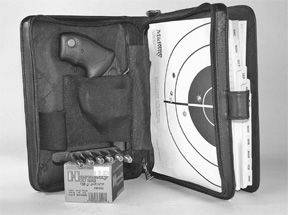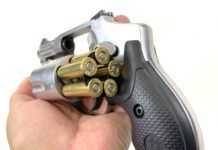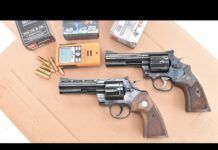
One of the most frequently asked questions among gun owners is how much does a self-defense gun cost? If you have enough money to choose any gun you wish, then the answer might be simple. But if purse strings are tight or you are new to handguns and would rather get some experience before spending a larger sum of money, then the question becomes more complex. We’ve tested “plain Jane” 1911 pistols that work perfectly well, and they cost hundreds of dollars less than custom models.
But if price is any gauge, revolvers offer even bigger self-defense savings than inexpensive semi-autos. To see if inexpensive wheelguns offer a lot of reliable bang for the buck, we bought three inexpensive .357 Magnums at our local gun shop, Pruett’s Guns and Ammo (832-237-GUNS, or www.jimpruett.net). We paid $250 for a Taurus 605B, another $250 for a Rossi R46102, and only $225 for a Comanche III revolver. As a bonus, each gun was capable of firing .38 Specials. This allows the shooter to fire less expensive ammunition and experience lower recoil.
[PDFCAP(1)]
The Taurus 605B was the only five-shot gun in the test. It was also the smallest in terms of overall dimensions. Similarity between the 605-series revolvers and the .38 Special-only 85 series ends with the 605’s larger cylinder, which accepts longer magnum cases and adds about 3 ounces of weight. The Taurus website lists both these guns as being 6.5 inches in length, but our revolver measured about 0.2 inches longer than that published length.
This gun offered concealable size and considerable firepower. The 605B is the base model, with options such as stainless-steel construction and a bobbed hammer that can increase the price to as much as $405. The taurususa.com website showed some 605 models with porting, but the accompanying specifications deny that porting is available on these models. The barrel of our 605B was not ported, but it was stainless steel. The gun had a full-length lug that enclosed the short ejector rod. The ejector rod was capped and did not play a part in cylinder lockup. To strengthen lockup, a spring loaded detent pin was added to the crane. The ramp-style front sight was machined as part of the shroud, and was lined to reduce glare. The rear sight was a simple notch in the topstrap, but we thought it provided a clear sight picture. The hammer offered a full spur, and there was a popup key lock inserted into the hammer to stop its movement and disable the revolver. The frame held the firing pin, and pulling the trigger exposed a transfer bar, which transferred force to the primer, causing ignition.
Flutes adorned each revolver’s cylinder. Rotation was counter clockwise, igniting the next live round in the chamber immediately to the right of the hammer. The smooth, rounded trigger face allowed comfortable trigger work, and the contoured cylinder release made ejection and reloading easier, especially when using a speed loader. The rubber grip had finger grooves on the front strap and a pebble finish on the sides.
The Taurus 605B was comfortable to hold, and the action was, for the most part, smooth and predictable. One chamber on the 605B was sluggish. The double-action trigger press was short and displayed little variation, except on the chamber mentioned above.
We ran a range rod through the barrel and across the cylinder gap to check timing and alignment between each one of the chambers and the bore. We found a slight misalignment in four of the five chambers. This was acceptable in light of the fact that we were using a match grade rod (part number, 080-617-138, $35 from Brownells, 800-741-0015) versus a service grade model with greater tolerance.
[PDFCAP(2)] we found that all the ammunition ignited, the cylinder release was smooth and secure, and both the double and single action triggers proved reliable. We did notice some spitting of debris from the cylinder gap, but all three guns did this. For collecting accuracy data we used two loads of .357 Magnum and one load of .38 Special +P. Hornady’s .357 Magnum 158-grain hollowpoint produced 354 foot-pounds of muzzle energy from the 2-inch barrel. Not far behind was the 110-grain JHP magnum load from Winchester. The lone .38 Special round from Black Hills Ammunition pushed its 125-grain JHP slug to an average velocity of 874 fps, producing 212 foot-pounds of muzzle energy.We shot each of these rounds from a sandbag rest at targets 15 yards downrange. Since these were defense guns and not target guns, we felt that double-action fire should be the primary focus of this test. Therefore, we fired all five-shot groups DAO with the Taurus revolver. This little gun shot 2.5 inch groups with all our test loads. No malfunctions or breakage occurred during our test of the Taurus 605B. It proved to be a rough and ready little gun.
[PDFCAP(3)]
Rossi’s manufacturer, BrazTech International, LC, has the same address in Miami, Florida as Taurus, which is not surprising since Taurus acquired the Rossi lineup some years ago. Both the Taurus and Rossi revolvers were manufactured in Brazil, and just like the Taurus product, the Rossi revolver came with a lifetime repair policy.
The Rossi R46102 differed from the Taurus revolver in at least three key aspects. First, its capacity was six instead of five rounds. Second, the frame was a little taller to accommodate the larger cylinder, which was the main reason why the Rossi revolver also weighed about 2 ounces more than the Taurus. The butt, or grip, portion of the frame was slightly different, but it was still rounded and about the same size as the one found on the Taurus. The supplied rubber grip was our favorite in this test, offering a bulbous shape to fill the palm.
Elsewhere, the Rossi R46102 had a nose-pin-style hammer, a detent pin at the crane, and a contoured cylinder latch. The Rossi also incorporated a key-operated hammer lock like that found on the Taurus revolver. At the range we found the Rossi R46102 was accurate. Our best five-shot group measured 1.5 inches center to center, and this lead to the best overall average of 2.0 inches firing the Hornady 158-grain .357 Magnum hollowpoints. But because we experienced cylinder bind on more than one occasion when firing the 158-grain rounds these results reflect groups fired single action only. This was contrary to our mission, which was to evaluate potential for accurate rapid double action fire. The Rossi did not seem to have any trouble cycling without ammunition in the chambers (dry firing), and the range rod test revealed only one chamber out of time. But after a couple of shots with the 158-grain magnum ammunition, the trigger press became difficult. We saw no evidence of the cylinder dragging on the forcing cone where the bullet enters the cylinder, but we encountered difficult ejection of spent cases. This could indicate a headspace problem (the distance between the rear face of the cylinder and the area surrounding the firing pin hole) or improperly sized chambers. The simple answer to the problem was to stick with the ammunition that worked. In this case loading both the .38 Special +P loads and the Winchester 110-grain .357 Magnum loads seemed to guarantee smooth operation.
[PDFCAP(4)]
The Comanche III is another revolver from South America, this time from Lasserre S.A. Fabrica De Armas of Argentina. The distributor for this revolver was S.G.S Importers International, Inc., of Wanamaker, New Jersey. Comanche revolvers are warranted to be free from defects in material and workmanship under normal use for a period of one year. The Comanche III was the largest and heaviest of our three guns. Barrel length was 3 inches, the maximum length for revolvers described as being snub-nosed.
The full-length ejector was completely shrouded, and the tip of the ejector played a role in cylinder/crane lockup. The front sight was tall, mounted upon a stanchion, and pinned into place. The rear sight also sat high on the gun and was adjustable for windage and elevation. This unit appeared to be cast rather than machined. Generally, we do not favor an adjustable rear sight on a carry gun, especially one that has a large unshielded notch because it is too vulnerable to being damaged. But we did appreciate the target quality sight picture nonetheless.
The cylinder release showed a unique contour and was comfortable to use as well as being out of the way when it came time to reload. The neoprene grips resembled those found on the Taurus revolver, but they did not actually fit the gun properly, in our view. They also seemed to be chipping and losing their surface coating. Graphics on the Comanche III were crude and machine marks were evident throughout. Our attempt to gauge chamber-to-bore alignment was blocked because we could not get the range rod further than halfway down the bore. The Comanche suffered from the roughest trigger, and we even had difficulty getting the trigger to return forward until it was broken in.
Our approach to testing these revolvers began with lubricating the guns thoroughly. Lubrication points were the bearing surface between the front of the cylinder and the ejector rod, the teeth of the ratchet, the point where the center pin contacts the frame, and the slot where the hand reaches through frame. We also put drops of oil into the action with the hammer pulled back. We then filled the individual chambers with snap caps and dry fired the guns relentlessly. In his video “S&W Action Job,” ($29.95 from CGC, 888-458-4126), Jerry Miculek refers to an old saying that a trigger job is equivalent to the wear of about 20,000 trigger pulls. We didn’t get quite that far with each gun, but in the case of the Comanche III, we did manage to break it in sufficiently to solve the trigger return problem. Another reason we dry fired the guns hard was to break them. In the past we have seen revolvers fail to stop the cylinder under fast double action fire, with telltale firing pin marks left on the surfaces between the chambers instead of on the center of the primers. None of our guns suffered such a break down.
But at the range, the Comanche III did display a very notchy trigger, and it bound so badly that we had to resort to single action fire to finish collecting data. The Comanche III had the most malfunctions of this type with the Hornady ammunition and to a lesser extent with the Winchester rounds. The Hornady rounds, fired primarily single action, produced barely acceptable accuracy at 15 yards. Accuracy with the 110-grain Winchester USA magnum rounds and the Black Hills 125-grain .38 Special +P rounds (fired primarily double action) produced five-shot groups that ranged in size from 1.8 to 2.9 inches in size.
Gun Tests Recommends
• Taurus 605B .357 Magnum, $250. Our Pick. This little five-shot revolver ran without complaint and delivered 2.5-inch groups with both the .38 Special and magnum caliber rounds. The 605B may not be a featherweight sidearm, but we found it easy to conceal and more comfortable to shoot than we would expect from a small .357 Magnum revolver.
• Rossi R46102 .357 Magnum, $250. Conditional Buy. The Rossi revolver we bought was reliable only with the magnum rounds that featured the light 110-grain bullets and the .38 Special ammunition we tried. Accuracy was very consistent. With the right choice of ammunition, you will be adequately armed with this revolver.
• Comanche III .357 Magnum, $225. Don’t Buy. This gun suffered cylinder bind when firing magnum rounds. As a .38 Special-only revolver, it might work okay, but that’s hardly a reason to recommend it. However, when loaded with full power .357 Magnum ammunition, our test sample Comanche III could not be relied upon.




























